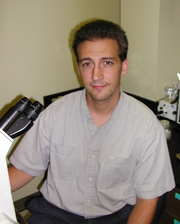
Research/Clinical Interest Cilia Signaling and Dysfunction in Development and Disease
Cilia are microtubule based structures that can be motile or immotile, the latter being referred to as primary cilia. In contrast to motile cilia, such as those found on epithelia of the trachea, the importance of the primary cilium is relatively undefined despite their presence on most mammalian cells. Cilia are extremely complex organelles which are devoid of ribosomes, thus, proteins required for cilia assembly, maintenance, and signaling must be imported into the cilium. This occurs through a microtubule-based transport system called intraflagellar transport (IFT). Proteins involved in IFT concentrate around the basal body at the base of the cilium and assemble into complexes (IFT particles) which are moved up the cilium by a kinesin and returned by a cytoplasmic dynein. The IFT particle is thought to mediate the transport of cargo into the cilium as well as to deliver signals initiated in the cilium to the cytosol. Although the primary cilium was once thought to be a vestigial organelle, recent studies have uncovered that cilia in mammals are required for viability and that dysfunction of the cilium is associated with a large number of developmental abnormalities and disease phenotypes. This now includes obesity, cystic kidney, liver, and pancreatic diseases, hydrocephalus, skin and hair follicle abnormalities, random left-right body access specification, and skeletal defects. Although studies in mice and humans now indicate that cilia are critically important organelles, the functions of cilia and the pathways in which they are required remains largely unknown. Addressing these issues is the major focus of Dr. Yoder’s group’s research. The group studies utilize comparative approaches in both mouse and C. elegans to investigate four major interrelated themes: 1) What roles do cilia play in regulating signaling pathways? 2) What are the functions of cilia in embryogenesis and tissues physiology in postnatal life? 3) How does cilia dysfunction cause disease and developmental abnormalities? 4) What proteins localize in cilia, how are they targeted to this organelle, and what role do they play in cilia assembly or signaling activities?
Source: http://services.medicine.uab.edu/facultydirectory/FacultyData.asp?FID=3533